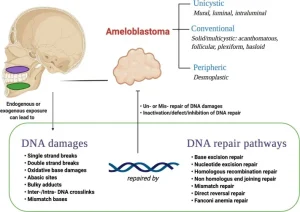Overview
Ameloblastoma is a rare, noncancerous tumor that most commonly develops in the jaw, usually near the molars. It begins in the cells involved in forming the enamel that protects teeth. Although benign, ameloblastoma can be locally aggressive and grow into the surrounding jawbone.
The most common form tends to grow slowly but can become quite large if not treated. As it enlarges, it may damage bone, shift teeth, and change facial appearance. Treatment usually involves surgery, and in some cases radiation therapy may be recommended. Reconstruction of the jaw or teeth may be needed after treatment to restore function and appearance.
Ameloblastoma is most often diagnosed in adults between the ages of 30 and 60, but it can also occur in children and young adults. Some types grow more slowly and are less aggressive, while others require more extensive treatment due to their tendency to recur.
Symptoms
Ameloblastoma may not cause noticeable symptoms in its early stages and is sometimes found during routine dental imaging. When symptoms do occur, they may include pain or swelling in the jaw.
Common signs and symptoms can include:
-
A painless lump or swelling in the jaw
-
Jaw pain or discomfort
-
Loosening or shifting of teeth
-
Changes in the shape of the face or jaw
-
Difficulty chewing or opening the mouth in advanced cases
If left untreated, the tumor can grow large enough to distort the jaw and lower face, leading to significant functional and cosmetic concerns.
When to see a doctor
See a dentist or healthcare professional if you notice persistent jaw swelling, pain, loose teeth, or any unusual changes in your mouth or facial structure. Early evaluation can help limit the extent of surgery and reduce the risk of recurrence.
Causes
Ameloblastoma develops from cells involved in forming the enamel of teeth. In rare cases, it may arise from gum tissue. The exact cause is not fully understood, but genetic mutations are believed to play a role in how the tumor forms, where it develops, and how quickly it grows.
Ameloblastomas are classified by their growth pattern and cell type. The main types include:
-
Conventional ameloblastoma, the most common type, which grows aggressively and most often affects the lower jaw
-
Unicystic ameloblastoma, a less aggressive form that usually appears in younger individuals and often develops near the molars
-
Peripheral ameloblastoma, a rare type that affects the gums or soft tissues of the mouth and has a low risk of recurrence
-
Metastasizing ameloblastoma, a very rare form in which tumor cells spread beyond the jaw
The likelihood of recurrence varies depending on the type and extent of the tumor and the treatment approach used.
Risk factors
Specific risk factors for ameloblastoma are not well defined due to the rarity of the condition. However, certain factors may be associated with a higher likelihood of diagnosis.
Possible risk factors include:
-
Being between the ages of 30 and 60
-
History of jaw tumors or cysts
-
Genetic changes affecting enamel-forming cells
Ameloblastoma does not appear to be linked to lifestyle habits such as smoking or alcohol use.
Complications
Although ameloblastoma is benign, it can cause serious complications if not treated properly. The tumor can grow extensively, leading to destruction of the jawbone, facial deformity, and difficulty with eating or speaking.
Other possible complications include:
-
Recurrence of the tumor after treatment
-
Need for extensive surgery and reconstruction
-
Rare transformation into a malignant tumor
-
Very rare spread of tumor cells to areas such as the lungs or lymph nodes
Long-term follow-up is important because recurrence can happen years after treatment.
Prevention
There is no known way to prevent ameloblastoma because its exact cause is not clearly understood. However, early detection can help reduce complications and improve outcomes.
Helpful preventive measures include:
-
Regular dental checkups and imaging when recommended
-
Prompt evaluation of jaw swelling, pain, or unexplained dental changes
-
Following long-term follow-up schedules after treatment to monitor for recurrence
Early diagnosis and appropriate treatment remain the most effective ways to manage ameloblastoma and reduce its impact on oral and overall health.
Advertisement

